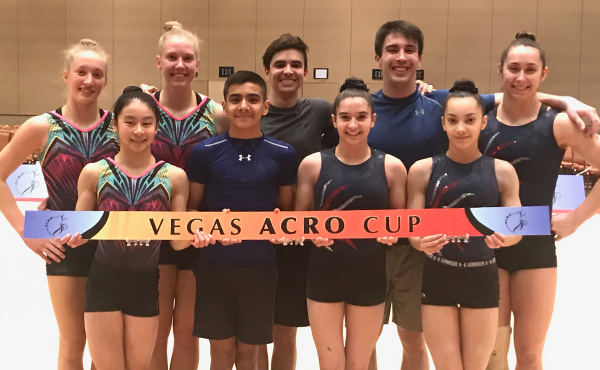
LAS VEGAS, March 21, 2019 – On Friday, the 2019 World Cup, the first International Gymnastics Federation World Cup for acrobatic gymnastics held in the United States since 2009, gets underway at 6:45 p.m. PT. Slated for March 22-24 at the Rio Hotel, Casino and Convention Center, the World Cup is part of the Las Vegas (Nev.) Acro Cup, an international invitational for 11 competition levels. Between the two events, more than 1,000 gymnasts from 18 countries will be performing over the three days of competition.
The U.S. Team for the World Cup features: 2019 Maia World Cup women’s pair bronze-medalists Emily Davis and Aubrey Rosilier, both of San Antonio, Texas/Acrobatic Gymnastics of San Antonio; 2018 U.S. mixed pair silver-medalists Aisley Boynton of Riverside, Calif., and Sean Obley of Mesa, Ariz., who train at Aspire Kids Sports Center; 2018 U.S. men’s pair champions Angel Felix and Braiden McDougall, both of Riverside, Calif./Realis Gymnastics Academy; and the U.S. women’s group of Elanor Chang of Columbia, Md., Grace Vonder Harr of Imperial, Mo., and Kayla Vonder Haar of Imperial, who train at Emilia’s Acro Gymnastics and Cheer.
The 2018 World silver-medalist men’s group from China of Zhi Fu, Pei Guo, Heng Jiang and Junshuo Zhang and Belarus’ 2019 World silver-medalist women’s group of Julia Ivonchyk, Veranika Nabokina and Karina Sandovich headline the international field that includes a men’s pair from Germany of Michail Kraft and Tim Sebastian, who were fifth at the 2018 World Championships; Great Britain’s mixed pair of Finlay Cockrane and Kirsten Owen; and Australia’s women’s pair of Katelyn Dullard and Tori Singleton.
Representing four continents, the 11 countries entering athletes in the World Cup are Australia, Belarus, China, Great Britain, Germany, Kazakhstan, Poland, Portugal, Russia, Ukraine and United States. This prestigious international event is the second of four World Cup events in the FIG’s 2019 acro World Cup series.
The World Cup competition schedule is:
- March 22, 6:45 p.m., qualification – women’s pair, mixed pair and men’s group balance routine, and men’s pair and women’s group, dynamic;
- March 23, 6:30 p.m., qualification – women’s pair, mixed pair and men’s group dynamic routine, and men’s pair and women’s group, balance; and March 24, finals. The top eight in each division advance to the finals.
Tickets for the event are available on each competition day at the venue. World Cup tickets are: $15/day or $35 for all three sessions, adults; $10/day or $25/all three sessions, seniors, military, children 6-12; and free, children under age 6.
Participating gymnasts can earn World Cup points based on their performances that count toward the coveted Acrobatic Gymnastics World Cup Series champion, which will be determined this fall at the conclusion of the series. At every World Cup, each pair or group will perform balance and dynamic routines. The pairs and groups that advance to the finals perform a combined routine.
In addition to the 11 countries also competing in the World Cup, Brazil, Canada, Estonia, Israel, Japan, Mexico, and Puerto Rico have confirmed they are sending athletes to the international invitational that has competition in 11 competitive levels and an anticipated field of more than 1,000 gymnasts. The levels are Junior Olympic Levels 5-10; youth; age-groups 11-16 and 12-18; junior; and senior. The international invitational begins on March 21, wrapping up on March 24. The number of routines performed by each pair or group depends on the level in which they compete.
Acrobatic gymnastics combines the beauty of dance with the strength and agility of acrobatics. Routines are choreographed to music and consist of dance, tumbling, and partner skills. At the elite level, each pair or group performs a balance, dynamic and combined routine. Pyramids and partner holds characterize the balance routine, while synchronized tumbling and intricate flight elements define the dynamic exercise. The acrobatic gymnastics events are: men’s pair, mixed pair, women’s pair, men’s group and women’s group. An acrobatic gymnastics pair consists of a base and a top. A women’s group is comprised of three athletes – a base, middle and top partner – while a men’s group has four athletes, a base, two middle partners and one top partner.
For more information about the Vegas Acro Cup World Cup and international invitational, visit the official website, www.vegasacrocup.com. Fans can also find coverage of the World Cup at usagym.org and its social platforms.




